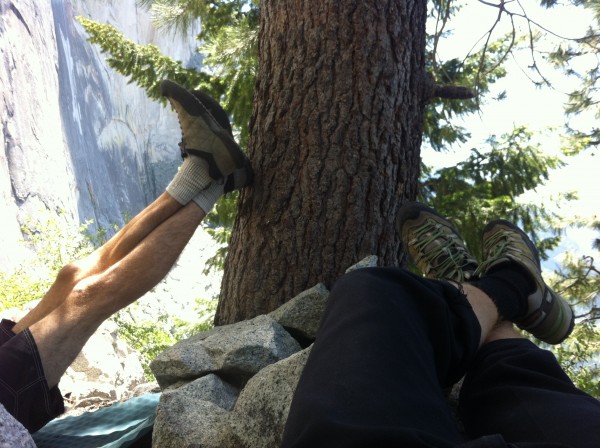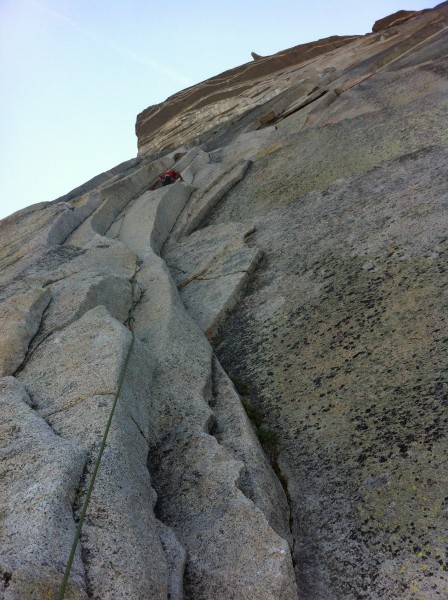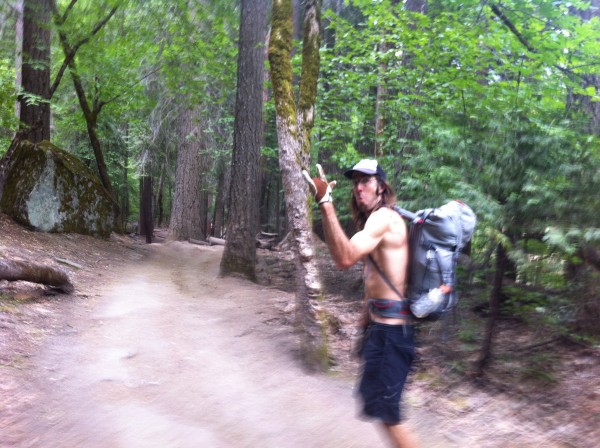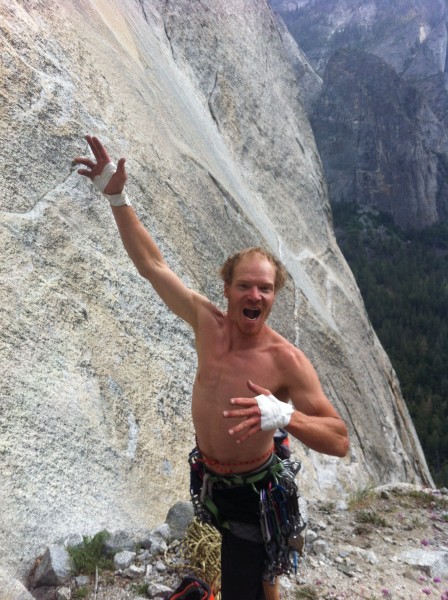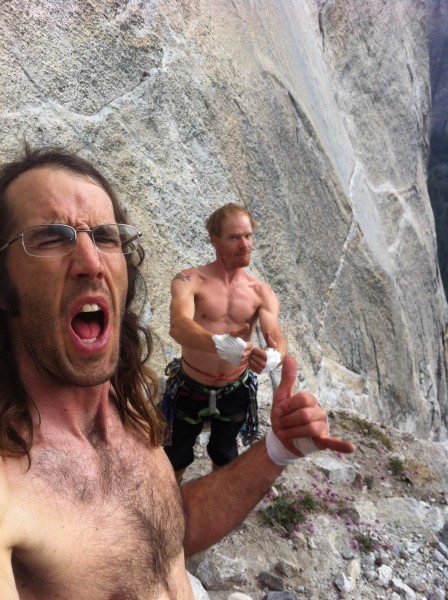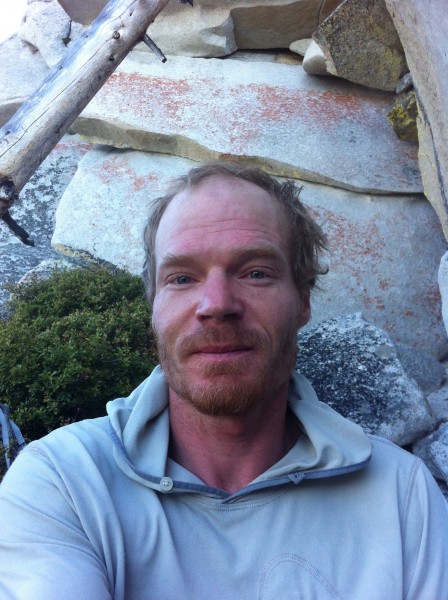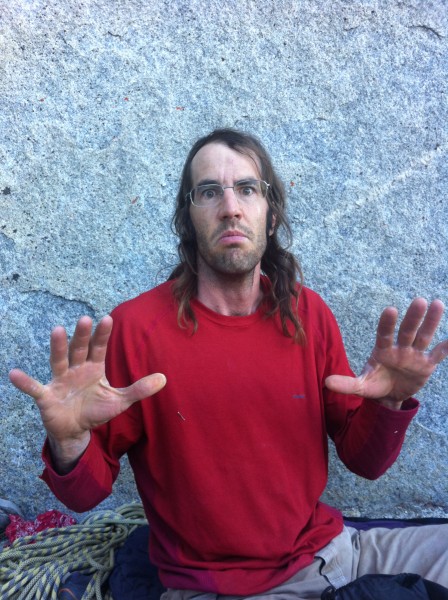What a Long Strange Trip Report It’s Been: Half Dome Regular Northwest Face (the Reggae Route) and El Capitan’s West Face—Both Free in a Day
This trip report tells my story of climbing these two routes over the course of 28 years, culminating in the first one-day free ascent of both routes in June 2013. Although not a world-class difficult link-up (the rating is only 5.12a; Honnold has free-soloed both routes), I feel as though it is a primo way for a 5.12 mortal climber to free-link the faces of Half Dome and El Cap in a day. It is much easier than climbing the Freerider and Half Dome (the “hardman” link-up) and much harder than combining the East Buttress of El Cap with Snake Dike (the “softman” link-up). I hope my story will inspire others to go for this world-class duo in a day.
The idea for this mega-free-climb started about five years ago. As far as huge formations are concerned, El Cap and Half Dome are in many ways the most obvious and monumental summits on earth. I had speed-climbed these two routes with Hans Florine 22 years earlier. The thought of now free-climbing them dawned on me as possibly one of the best objectives in the Valley. The Northwest Face of Half Dome has stacks of easy climbing on it, and the whole wall is slightly less than vertical, which means using lots of leg muscles. After sending this one, the West Face would be the perfect big route to add because the wall is also all less than vertical and the crux 5.11 pitches are over by pitch six, leaving your blasted forearms with 1,200 feet of 5.10 to the top. Both walls face west and see lots of time in the shade, a huge factor in the world of sunny Californian granite free-climbing.
The link-up game in the Valley has been played by the best of them since climbing in the Ditch first began. Some of the greatest, longest, and most exhausting days on rock have been had by Valley climbers pushing their limits by the time the clock reached 24 hours. Along the way we have witnessed standards and minds being blown time and time again. Bachar and Croft embodied the link-up tradition when they nabbed the granddaddy of them all—The Nose of El Cap and the Regular Route on Half Dome in a day. The story is well-known, culminating in the image of two legends standing on top of Half Dome with two rainbows crossing the thunderstorm-threatened sky. “A perfect day in the mountains,” as Captain Croft put it.
Since then, the different link-ups in the Valley have been extensive and creative, with a few of the most active locals always setting the bar for what could be accomplished in a day.
When talking about massive combined climbs, the difference between aid-climbing and free-climbing cannot be overemphasized. It is true that at the high end of hard aid there lies the craft and balls required for the equivalent of doing acupuncture on a sleeping bear. Hard aid is its own beast, requiring tons of experience with specialized gadgets, lots of time and patience on long drawn-out leads, and balls the size of death blocks. But the realm of easy to moderate aid is pretty much vertical backpacking. When one begins to pull on good gear and stand in aiders, the game of climbing is reduced to doing basic pull-ups. This is especially true on the long trade routes, where gear is bomber and success depends solely on the climber’s ability to plug the next cam and hang on his harness. Even on long link-ups (such as the Nose and Half Dome in a day), although speed and endurance are essential, success is rarely in question if you’re moving at a good clip and your legs and arms can keep pulling on bomber holds. When it gets hard, the leader pulls on gear, and once the rope is fixed, the second jumaring is basically like a marathon runner jogging another half-mile before hitting the next rest and refreshment stop.
Free-climbing leaves the success of the ascent constantly in question. On hard team free routes—where both climbers intend to free all the pitches and are at their limit—one tiny slip or one off-balance moment can mean success instantly slips through their fingers. The free ascent is suddenly gone. Leaders must be lowered, ropes must be pulled, and tired muscles and mind must regroup in minutes to give pitches another go. Disheartened and exhausted, the free climber prays for success, tries harder than ever, but often tops out disappointed, even though he climbs the wall and the summit is reached.
Free-climbing link-ups on major Valley routes are some of the most strenuous and impressive examples of rock climbing mastery ever performed. Two days stand out as the most difficult multi-route free-climbing days ever: Tommy Caldwell’s impressive performance on the Nose and Freerider, and Caldwell and Alex Honnold’s mind-blowing team ascent of Mt. Watkins’ South Face, El Cap’s Freerider, and Half Dome’s Reggae Route. In addition to these, Dean Potter’s visionary ascent of El Cap’s Freerider with Half Dome’s Reggae Route has earned the new reputation of the “hardman” free link-up in the Valley. This feat has been repeated by only four others: Leo Houlding, Sean Leary, and Honnold and Caldwell, as mentioned before. Although not technically very difficult for many amazing world-class climbers these days, climbing Freerider and Half Dome free is a daunting task requiring unfathomable fitness, skills and speed. It is doubtful that the Freerider-Half Dome duo will become commonplace (as the gladiator-style Nose-Half Dome combo has become), when one considers the difficulty of free-climbing both routes in a day.
My personal history with the Half Dome’s Regular Route goes back to when I was 14 years old. It was 1986, and I was a freshman in high school, growing up in the San Fernando Valley of Los Angeles. Climbing gyms hadn’t been established in the U.S. yet. The landscape was vapid; the giant sprawling metropolis presented few options for a restless teenager to apply himself to something engaging and meaningful. I had experimented with many hobbies and sports—art, skateboarding, drugs—but it wasn’t until I signed up for a rock climbing class that I got sucked in deep.
Before I even knew how a top-rope set-up worked I went to A16 and blew my life’s savings on a rope, harness, a few biners, and some webbing. I laid out the gear and fondled it like it was a pile of buried treasure. I read Royal’s Basic Rockcraft and that weekend headed for Stoney Point. It was my second day climbing ever. I had set-up a top-rope on Beethoven’s Wall on the backside of Stoney and was trying to get myself to try my hardest on the easiest 5.7 route. The thought of weighting the rope was petrifying. An older dude came along and asked for a ride on my TR. As I belayed him through my stich plate I marveled at his grace and fluidity. He made it seem effortless, like he was hiking on a trail. The 5.9 route he took was impossible in my eyes, and he was the best climber on earth as far as this 14-year-old boy was concerned.
It turns out he was Larry Zulim, a long-time Valley local who lived on the rescue site for the better part of 20 years starting in the late Sixties. He had been tight with all the Stone Masters and had repeated most of the Valley classics, especially the free climbs. After he lowered down we started talking. I was eager to know anything about rock climbing, literally anything. Within the first few minutes he mentioned that he had done El Capitan and Half Dome. That was it; this guy was god. The next sentence out of his mouth latched onto my pubescent brain like breath to a drowning surfer, “Oh yeah, El Capitan and Half Dome…those are the goals.” Clear as the sky, the Way had been shown to me by a master.
Eight months went by and I turned 15. I did anything I could to get a ride to Stoney every week, where I flailed around top-roping and bouldering and probably annoying most of the older guys with my eager attitude and big mouth. One man, a 35-year-old named Jeff Batten (the late Juan de Fuca on Supertopo), heard me ramble at Boulder 2 about Yosemite and my desire to go there. Being generous and perhaps a bit nuts, he asked if I wanted to give Half Dome an attempt. I had been to Yosemite on a school trip and gazed up at Half Dome from Mirror Lake. I had even seen a National Geographic movie on the first free ascent of the face. It seemed an unreal invitation, a monolithic trophy in my teenaged mind. It was arranged that he would meet my parents (for all of five minutes!), and we would head up in July to give the Northwest Face a try. I needed good shoes for a big climb, so I bought some flat-soled wrestling boots because they could double as hiking shoes. (I hadn’t bought a pair of Fire’s yet, still convinced that regular shoe rubber was just as sticky and a lot cheaper.)
We trudged up the Mist Trail with the tourons, calling them tourons the whole way. The all-day sunny hike was big, but my skinny-assed six-foot-four 160-pound frame carried the huge load well. If one approaches the face of Half Dome from the shoulder below the cables, there is a certain spot when the wall first comes into view, and your eyes pop while your heart drops. The enormity of the world’s largest monolith hits your gaze and you realize why they call these things big walls. I was instantly terrified.
As we approached the base we encountered something we didn’t expect, four other parties camping there ready to blast in the morning. One studly-looking dude (who turned out to be on YOSAR) came up and introduced himself as Mike and filled us in on the pecking order: “There are four parties so you guys are fifth in line tomorrow.” My partner Jeff, who fancied himself a rebel, took about five seconds to assess the situation as bunk and declared, “OK, we’ll just start climbing right now.” Of course, this took me by surprise, but I just nodded in silence. Mike wasn’t too stoked on this and tried to play the local sheriff: “You guys can’t climb at night! That’s…uh…it’s dangerous!”
We pretended not to hear as we strode off to the base of the first pitch and started doing our thing. We made it to pitch six by dawn, moving through the night like the newbie slugs that we were. All day we slogged, slow and steady, through the chimneys, which nearly killed me with fatigue, to right below Big Sandy Ledge by the time the clock struck midnight. Here we discovered Jeff’s beer and Jolt Cola had exploded all over our clothes in our backpack, which were our only bivy gear. We huddled—an unlikely pair, the 15-year-old boy and the 35-year-old man—keeping warm until Jeff could lead up the Zig-Zags at dawn.
Topping out in the early afternoon, elated, we hiked down for a total trip time of 65 hours, including only about five hours of sleep—the longest grueling effort of my life. For Jeff I believe this was his last big wall, a burly effort. But at age 15 I thought this meant I could get up anything. I was invincible.
In 1990 at age 18, Hans Florine and I linked Half Dome with the West Face of El Cap, perhaps the only time these two routes have ever been linked. We climbed Half Dome first and raced over to El Cap Meadow with the plan of climbing the Nose and then the West Face, trying to be the first party to do three big routes in a day. After walking out to the old log in the meadow (which is now gone), we were greeted by three figures standing there chatting; their names were John Bachar, Peter Croft, and Dave Schultz. Of course my 18-year-old self was dumbfounded in admiration, though I was pretty proud about what we were up to. We told them that the Nose was next, but as we all turned our necks to look at the wall we were shocked to see eight parties between Sickle and El Cap Tower, hardly conditions stoking a fast party to blast. We opted for the West Face and ended up calling it quits after having linked the two routes in around 11 hours. Over the next two decades I climbed the Reggae with a variety of partners in a bunch of styles, including freeing it with Brent Obinger in 2008.
Free-climbing the Regular Route on Half Dome has to be one of the greatest goals in North America accessible to the moderate 5.12 climber. Possibly the most recognized piece of rock on the planet, this Californian icon has called to climbers since it was first seen by settlers in the late 1800’s. The Northwest Face was originally put up by Royal Robbins, Jerry Gallwas and Mike Sherrick in 1957. Their route was first freed in 1976 after a few years of effort by visionary Colorado free climbers Art Higbee and Jim Erickson, who spent weeks on the wall figuring out variations to bolt ladders and other points of aid. Their obsessive efforts and multiple trips made this the most historically significant nabbed free ascent by a couple of non-locals in Yosemite history.
These days Half Dome is getting more and more traffic by free-climbing parties. It is commonplace to see teams sending the route, although few have success on their first attempt. There are three pitches of 5.12a on the route, and two of 5.11. The Higbee-hedral (named after the late, great tall man Art Higbee) is the first free variation and has cleaned up over the years thanks to some climbing and some brushing. The bouldery nature of its 5.12a crux takes away the bite of the pitch and makes it a fun, protectable variation to the first bolt ladder. The Huber brothers added their own variation, which goes right of the bolt ladder, and is called the Huber-hedral. This pitch gets much less, if any, traffic and looks a bit more sustained than the Higbee.
Up higher on the wall, after a romp of mostly 5.9 climbing, the Zig-Zags present the next crux. The Zig-Zags—some of the cleanest, whitest dihedrals known to man—are perched high on the face of Half Dome right below the intimidating brow of the visor glaring down at all who approach. The visor gave Royal Robbins and crew the willies as they approached day after day, progressing on the first ascent of the Half Shell in 1957, until finally finding Thank God Ledge cutting 100 feet straight sideways and allowing the team to completely skirt the threatening visor. One can spot the Zig-Zags from almost any view of Half Dome in the Valley, and can easily pick them out in photos, such as Ansel Adams’ famous shots of the monolith taken way before human foot had ever stood on Big Sandy Ledge.
The famous dihedrals begin with an all-time 5.11+ lieback off Big Sandy, which leads into some juggy, steep 5.10 corners. Then, as the aid line finishes up and left and goes free at 5.12d, the less skilled modern free climber usually sets out right from the “hole” belay on a perfect 5.11+ fingertip undercling with a bald, vertical, featureless face for the feet. To set out on the undercling is probably the most intimidating moment of the climb because placing gear for the first twenty feet is nearly impossible. The undercling soon turns a small corner and is followed by a pumpy 5.12a lieback, which is the crux endurance section of the route. Both of these awesome Zig-Zag pitches have come down a notch by having nuts fixed over the years, making the leads a lot easier and much less scary.
With the Zig-Zags over and the top close, Thank God Ledge makes the free climber feel like it’s in the bag, but it’s not over yet. The final slab after Thank God Ledge is no gimme, and has hosted many dramatic free-climbing battles for those who wish to go home with Half Dome ticked on their send list. Even if you’ve got the slab completely wired, you never know if free passage will be granted. Beautifully sculpted dishes guide your feet but frustrate your hands, as you paste and stand up over and over again, trying not to doubt each foothold’s friction, knowing it only has to hold for a few seconds until the other foot latches on to the next smear. After four bolts of this pasting game there comes a good 15- foot runout to the last bolt. Here, the final jug on Half Dome lies a mere five feet away, staring the free climber in the face like a cool drink of water. However, keeping it cool here ain’t easy because right in front of your face there appears to be, well, nothing. A solid 5.12a paste-the-feet-and-stand-on-sketchy-smears move decides the free climber’s fate—success or heartbreak?—on the most recognized face of rock on the planet.
Here is the move that stopped Jim Erickson and Art Higbee on their free push, crushing their single-push ascent and ultimately bumming them out. Erickson returned later and led the pitch as a single-pitch endeavor, finally freeing every move of Half Dome. This is the spot where Honnold second-guessed his choice to solo Half Dome and tempted himself to pull on the bolt and take a magic ticket to sanity. Because there are no handholds and the feet are terrible, and it’s the last pitch of the face of Half Dome, this move for Honnold may have been the scariest move ever performed by a free-soloist. I have two buddies (Matt Ciancio and Jason Lakey), who had to pull their ropes and re-lead this famous slab pitch six and seven times respectively on their send days after slipping continuously on this last move. Another dude (Cody Simms), when going for the “hardman” link-up with Freerider, was stopped on this move three times and forced to throw in the towel on an extraordinarily rad effort. This is the very spot where Chief Tenaya mystically clouded up the sky for Yosemite’s native son Lonnie Kauk, who then stuck to the rock better and finished his flash ascent of the Reggae a couple of summers ago. If you are blessed with free passage and your feet stick, you grab the jug and Half Dome is yours.
The West Face of El Cap is one of the lesser-travelled golden lines in the Valley. Hidden around the corner left from the West Buttress, few people ever have a good vantage point to see the wall. But if one parks by the river a half-mile back from El Cap Meadow, the enormity and beauty of this lesser-travelled side of El Cap strikes the eye as one of the largest, smoothest faces in the Valley. Originally put up by TM Herbert and Royal Robbins in 1967, the route was freed in 1979 by Valley hardmen Ray Jardine and Bill Price. Over the years it earned a reputation as a fierce, old-school free climb, requiring strong fingers, stellar slab technique, and the ability to climb tricky sections of diverse rock where face holds often appear out of nowhere and when crack features disappear. In addition to the hard climbing, the West Face was known for some pretty manky belays, with many jingous quarter-inch bolts, pitons that had pulled out in critical spots, and one belay after the last 5.11 pitch that consisted of a rusty quarter-incher backed up by a #0 TCU. In the past few years the belays and the pins have been replaced and the West Face is now safe-feeling and ready for enjoyable, safe free attempts. However, most climbers still aid the route, intimidated by its length, its reputation, and the fact that it’s still considered a big wall on a massive formation called El Capitan.
What sets the West Face apart from any other free climb of its length in the Valley is the type of rock on that side of El Cap. Mostly a combination of the black diorite, the primo melty, polished orange rock, and classic white granite, the West Face has potentially more bomber buckets on it than any granite wall climb on earth. Over half the pitches on the route follow cracks that are lined on either side with giant bomber buckets and positive wrap-around jugs. The climber is always met with a friendly handhold, and right next to it the undulating crack pretty much takes any size cam or stopper. It’s friendly dream climbing.
One certain pitch stands out. In the middle of the route, pitch seven is a 5.7 traverse right for 100 feet to a belay. From the belay the climber stares up at the next pitch and the route-finding gets really confusing, with four different crack systems all disappearing out of sight above some bulges and roofs. The best-looking one out left ends up on terrifying 5.10 face above the overhangs with no gear for 50 feet. The conservative climber heads way right to slabbier terrain where the cracks turn to unpleasant grooves and the rope drag turns your rope into a 100-pound steel cable. After having climbed the route seven times I still didn’t know which way to go at this point. It took the adventurous spirit of Chris Sharma to figure out this section for me. When he got to this pitch, with his usual boyish enthusiasm for the impossible, he gazed up at the dirty-looking crack in the middle of all the options and exclaimed, “Look at that horizontal roof up there! I’m gonna go that way!” It was the last option anybody would have tried, but to our delight and the delight of others who collect beta, the three-foot-long horizontal roof turns out to be a 5.8 bucketfest where the climber can cut loose his feet and laugh at the glory of the West Face’s incredible featured stone.
Finding the right partner to link the Regular Route and the West Face was not easy. My ideal partner needed to have intimate knowledge of both routes free, and most importantly, he needed to be fast. In order to be successful on this link-up, Half Dome would need to be free-climbed in about eight to nine hours, which is pretty speedy for most parties. He also needed to be someone with passion and respect for the project. Yosemite climbing has been my spiritual spine since age 14 when I first pushed my way up the Northwest Face. After 27 years of climbing both of these route numerous times, I knew this link-up day would be a peak in my career, a symbol of my long-lasting relationship with these two mothers of all monoliths.
I met Peter Chapman climbing on the Eastside. Standing about five foot-seven-inches tall with scraggly red hair, and built like a pit bull, Peter exudes a calm confidence and surety with everything he does and says. Living in Mammoth Lakes, he is the kind of unassuming mountain man whose talent as an athlete is only realized when watching him execute on the stone, snow, or trail. Currently a math teacher at the local community college, holding a Master’s degree in mechanical engineering, our local crew has nicknamed him “the Professor.” However, his skills at crunching numbers are offset by another side of him, the side that shows up at the crag with his climbing gear in a handmade African basket instead of a backpack. As a devout student of Peruvian Shamanism, his attention to reading the stars and letting the universe be his guide made him just the right guy for this big hippie to hook up with. Peter would refer to the “Ninja mind” he acquired from a silent ten-day Buddhist meditation retreat (after having skied over the High Sierra to get to the retreat). His style of training relied more on strange personal routines than actual big days of climbing. These included hanging on the stair of his condo with his feet on a chair in front of him, breathing, or traversing two feet off the ground at a local bouldering spot, which is hardly worthy of a visit but is his staple for staying fit. When finding a trail he would channel the bear spirit, when wondering what to do with his life, he would disappear into the mountains and consult the oracle. Together, with both of us aligned, mysticism would certainly be the most powerful tool we had to complete our project.
Originally from Minnesota, Peter has a toughness that shines through when he greets you in the morning with a big gash in his face where his skis hit him the day before, and a lightweight thrift-store sweater to keep his style intact. As we’d drive the 395 on our way to the Alabama Hills for a day of guiding underprivileged kids from the L.A. area, we’d talk about the Sierra, routes we’d done, and plans for the future. With an unassuming chuckle in his voice, Peter would drop hints of his vast Sierran resume by pointing out the car window, the start canyon where he led a group skiing across the range, the East Ridge of Williamson, the West Ridge of White Mountain Peak, this chute and that chute, some of the biggest ridges and faces in the range. Peter’s Valley resume was not as thick, but in a sincere, boyish voice he would rhapsodize about his dream of becoming a “Valley climber.” Only a year before he had done his first NIAD in a typical 20-hour push, as well as an ascent of Watkins in a day, hardly the kind of veteran Valley resume on the trade routes that usually precedes a monumental link-up. However, Peter’s intention and excitement when he said those words “Valley climber” were filled with respect and awe, the kind of reverence mixed with fear that epitomizes the true Valley disciple.
Link-up day came after six months of sporadic, uncalculated training and a rehearsal run on each route. We camped at the base of Half Dome the day before in order to relish the experience. The wall was quiet. Living in the Eastside, we made our “locals” routine to leave the house at midnight, hike the death slabs, send the route, and head home in 24 hours. Waking up in our tent only 50 feet from the first pitch seemed like cheating. Things went ultra-smooth for us, and after having navigated the scary 5.11 pitch that cuts left toward the Higbee-hedral (with one worthless, rusty quarter-inch bolt for the 5.10 climbing), we were met with a fresh Higbee-hedral, having been cleaned, scrubbed, and primed by our good friend Jason “Coach” Lakey only two days before. The boulder problem’s difficulty came down a notch because of Coach’s cleaning efforts, and the Higbee was now starting to look more like a classic 5.11 corner than a dirty seldom-travelled variation. Once the route gains the main wall around the Robbins Traverse, the original free variation cuts up and left into rarely-travelled 5.10c terrain that has the reputation of being lame and loose. After having climbed it many times, I can say that this reputation is well-deserved. There is no chalk, no fixed gear to follow, and a lot of loose rock. Three times up this section I would examine a good hold on the wall and deem it solid, only to pull off a dinner plate into my hand that seemed to be glued perfectly to the wall with moss and stuff the plate into a crack. Needless to say, I quickly learned to stay away from anything that wasn’t obviously a major crack.
Navigating this loose free variation is quite nerve-wracking because of the number of climbers often scattered on the pitches below. Peter deemed it environmental climbing, where we must tread extremely lightly, as if walking on shells. After a few hundred feet, dirty ledges are reached and a 150-foot 5.10a downclimb leads to the 13th pitch ledge where the Regular Route joins in.
The enjoyable window pitch is next. Here the free climber, when faced with an unprotectable 5.9 squeeze chimney, instead heads for a big hole of light through the back of the chimney. Once you pop out the window you find a perfect 5.9 hand/finger crack that leads right up to a mellow 5.10a face move reconnecting to the belay at the bottom of the Half Dome chimneys. This variation pitch is truly a gem! Peter crushed the chimneys, and we found ourselves sitting on Big Sandy with only 4:30 elapsed.
At the third Zig-Zag our team had a moment where our mission was in jeopardy. Peter flamed out, having never led the pitch before. After two tries his forearms couldn’t recover in time and I took over the lead so that he could send the pitch on top-rope and we could continue toward our goal. The slab pitch was more of a three-minute dance than a rock climb, as we trusted our feet like never before. After an elapsed time of 7:30, we found ourselves sitting with the tourists enjoying their generous offering of a Mojo Bar. We were ahead of schedule!
We raced down the outside of the cables headfirst, taking in the tourist awe that makes most Half Dome climbers feel like superheroes compared to the average petrified hiker. We dreaded the hot midday sun we would expose ourselves to on our descent. This day Chief Tenaya was with us and an atypical unthreatening cloud layer calmed the Valley heat, creating the perfect temps for our slabby descent. After hitting camp at the base we let our legs run down the slabs and found ourselves back at the truck in 90 minutes from the summit—not exactly as fast as the base jumpers, but not bad for a terrestrial descent. El Cap Meadow greeted us with a cooler full of food and a river of freezing relief. We soaked and laid around with our feet kicked up on a pine tree, letting the blood recede into our core and pretending for an hour that we were enjoying a relaxing afternoon in the meadow.
An hour later we headed up to the West Face, with friendly cloud cover still blocking the sun all the way to El Cap, where, to the west, blue sky could be seen just beyond the mouth of the Valley. As we marched up the talus and approached Lurking Fear, a party was heading down. Not being the spraying type (I’ve never met Tom Evans or appeared on the El Cap Report, and I avoid the bridge like the scene that it is), I said to Peter, “If they ask what we’re doing I’m gonna tell them we just freed Half Dome and are linking it, dude.” Well, lo and behold, who should it be but Chris Mac, Mr. Supertopo himself! “What’s up, Chris?” I shouted. “You’re just the guy I want to talk to!” I proceeded to spout about our day. Being the veteran hardman he is, Chris quizzed us properly by asking, “How do you feel?,” the right question for the middle of a major day. Chris gave us props and we headed upward.
Our timing was perfectly calculated, and The West Face went into the shade at precisely 6:00 p.m., a necessary thing considering the micro-edging slab climbing on pitch one. Things went smoothly as planned until the final 5.11+ overhanging pitch. Although this pitch is highly featured and short, it’s steep, and for years I had known it would be the crux of this link-up as it tests the forearm pump at around pitch 30 of the day. In total darkness now, I put on my headlamp, determined to breathe hard and throw myself at it. Right at the lip my right hand grabbed the sloping bump, my fingers did their best, and that was that. I found myself whipping 25 feet into the void. Three extremely loud, bellowing choruses of “F*#k! F*#k! F*#k!” filled El Cap’s west gully. For a few minutes I sat there in a daze, watching my five year dream falling apart. There was absolutely no way I was going to try for this goal twice, it was now or never. I lowered down and tried again. Same huge whipper. Luckily, with a team ascent, I had an option. This time it was Peter’s turn to save the day for the team. He pulled the rope, sacked up, and waltzed the pitch with ease. I top-roped and we took our time enjoying the final thousand feet of our day, wallowing in the night sky, pointing out constellations, relishing the movement of rock climbing which felt more energizing than sitting still, and reflecting on the 28 years of climbing these two routes that all came together on this magical day.
Notable Valley Free Link-Ups:
Tommy Caldwell and Alex Honnold free-climbed the South Face of Mt. Watkins (5.13a), Freerider (5.13a), and the RNWF of Half Dome (5.12a) in a day.
Tommy Caldwell free-climbed The Nose and Freerider in a day (that’s right, The Nose and Freerider in a day).
Dean Potter free-climbed the Regular Route on Half Dome and then free-climbed Freerider on El Cap in a day! This feat, known as the “hardman link-up,” has been repeated by four other climbers since Dean’s visionary link-up in 2003.
Steve Schneider free-climbed The Rostrum (roof finish), the West Face of El Capitan, and Astroman in a day.
Peter Croft and Dave Schultz free-climbed the Rostrum via the Excellent Adventure finish (5.13a), Crucifix, West Face, and went up a few pitches on Astroman in 24 hours.
Peter Croft free-soloed Astroman, the Rostrum, and pretty much everything at the Cookie (Hardd, Crack-a-go-go, Outer Limits, Orangutang Arch, Red Zinger, The Nabisco Wall, Catchy, and Catchy Corner in a day. He was headed next to New Dimensions but was "a bit blurry" so he called it quits.
Jake Whittaker and Brad Carter free-climbed Astroman, the Chouinard-Herbert on the Sentinel, and the Rostrum in a day.
Matt Ciancio and Brent Obinger free-climbed Astroman, Crucifix, and the Rostrum in a day.
I’m sure there are many other amazing free link-ups that I do not know about, so cheers to all who have pushed hard for the 24 hour mark!
